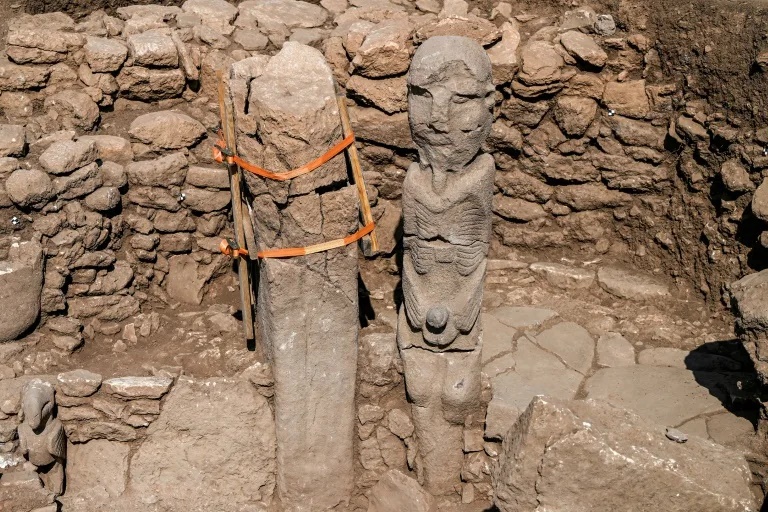 For researchers, a sculptural figure of a man sitting on a bench decorated with leopards and holding a phallus in both hands is a new clue to solving the mystery of our beginnings (Ozan Kose)
For researchers, a sculptural figure of a man sitting on a bench decorated with leopards and holding a phallus in both hands is a new clue to solving the mystery of our beginnings (Ozan Kose)
New discoveries, including a stone phallus and a colorful boar statue, have been made in a vast, arid region of southeastern Turkey that is home to some of humanity’s oldest archaeological sites.
For researchers, a sculpture of a man sitting on a bench adorned with a leopard, holding his penis in both hands, offers a new clue to the mystery of our beginnings.
The 2.3-metre (7.5-foot) tall piece was discovered in late September in Karakhantepe, the center of about 20 archaeological sites that were home to thousands of people during the Stone Age.
Karakhantepe is part of the network surrounding Göbekli Tepe, a UNESCO World Heritage Site. Göbeklitepe is the place where our prehistoric ancestors gathered for worship, more than 7,000 years before Stonehenge and the oldest Egyptian pyramids.
Necmi Karul, head of Istanbul University’s prehistory department, discovered the toppled statue, broken into three parts.
“We have found several statues of this kind… but here we have found a phallus for the first time,” said the archaeologist coordinating work on the project, which focuses on settlements in the area.
The man was lying on one of the original rectangular structures, probably used as pillars to support the wooden roof. This provides clues as to how people used this place.
Karul said the settlements were evidence of “a new social order that emerged after the Ice Age.”
“The main reason for starting a new kind of architecture is to build a new kind of society,” he said.
~Another 150 years of progress~
Göbekli Tepe, which some experts believe was never actually inhabited, is a vast expanse surrounding other nearby hilltop ruins that archaeologists believe may be even older. It may be part of a sacred landscape.
But a modest photo of the statue, first released by Turkey’s Culture Ministry, led local media to question censorship in the Islamic state, which has taken a conservative turn under President Recep Tayyip Erdogan. Ta.
“We’re archaeologists. There’s no censorship! We hadn’t discovered the penis yet,” the archaeologist said with a laugh.
But the discovery has hidden implications.
“They (residents) were smashing pillars and statues before leaving the site, and earlier they had broken noses and phalluses,” he said.
The site was then reclaimed and buried under tons of sand and soil.
Its function remains unknown, and it is also unclear why it was suddenly abandoned and destroyed after apparently being used for hundreds of years.
The largest room on the site, surrounded by smaller rooms, was a kind of gathering hall, accessed through a narrow passage supported by a forest of phallic-shaped columns topped with a man’s head carved from the rock. It seems like it was.
“The people who came in here knew the symbols… They knew the meaning, it told them a story, and we don’t know that,” he said. He added that the woman had not been found.
Perhaps they were made of wood, he suggested, but speculation was dangerous.
As soon as Karl had excavated the Karakhantepe man, he made another discovery in the same week at Göbekli Tepe.
Archaeologists discovered a carving of a wild boar measuring 1.2 metres long and 70 centimetres high (4 feet by 2 feet), with black and white skin, red eyes and teeth.
This 11,000-year-old wild pig is the first painted sculpture of this period ever discovered, Karl said.
The site was inhabited for approximately 1,500 years before being abandoned.
Of the 20 regional sites of the Tash Tepe (Stone Hill) project co-ordinated by Karul, spread over 120 kilometers not far from the Syrian border, only nine have been excavated.
“Work for the next 150 years,” Kalulu said, adding that both the man and the boar decided to stay where they emerged, taking the necessary steps to protect them.
AFP


